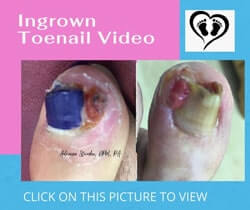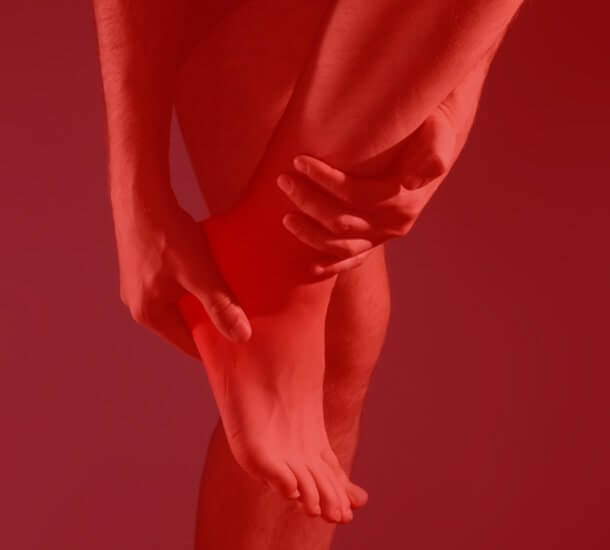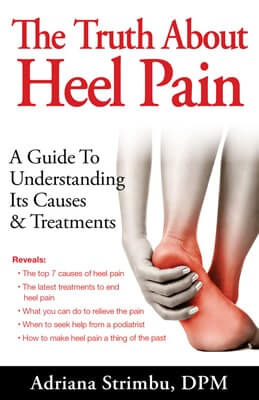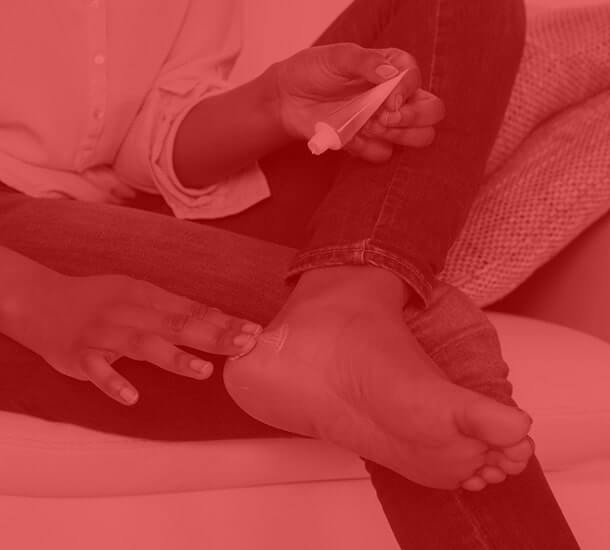
Are you experiencing pain from an ingrown toenail? Is your toe red, painful, swollen and/or infected on the side of toenail, usually the big toe? Ingrown toenails can be very painful, but they are easily treated by a podiatrist.
Our Hallandale Beach office welcomes you. You are at the right place. Our podiatrist is very experienced in the treatment of ingrown toenails, nonsurgical and surgical treatments.
You don't have to suffer anymore. We are here to treat your ingrown fast and effectively and as painless as possible.
Booking an appointment is easy. Book an appointment online now by clicking on this link or call our Hallandale podiatry office at (954) 455-9404.
Pictures of Ingrown Toenails
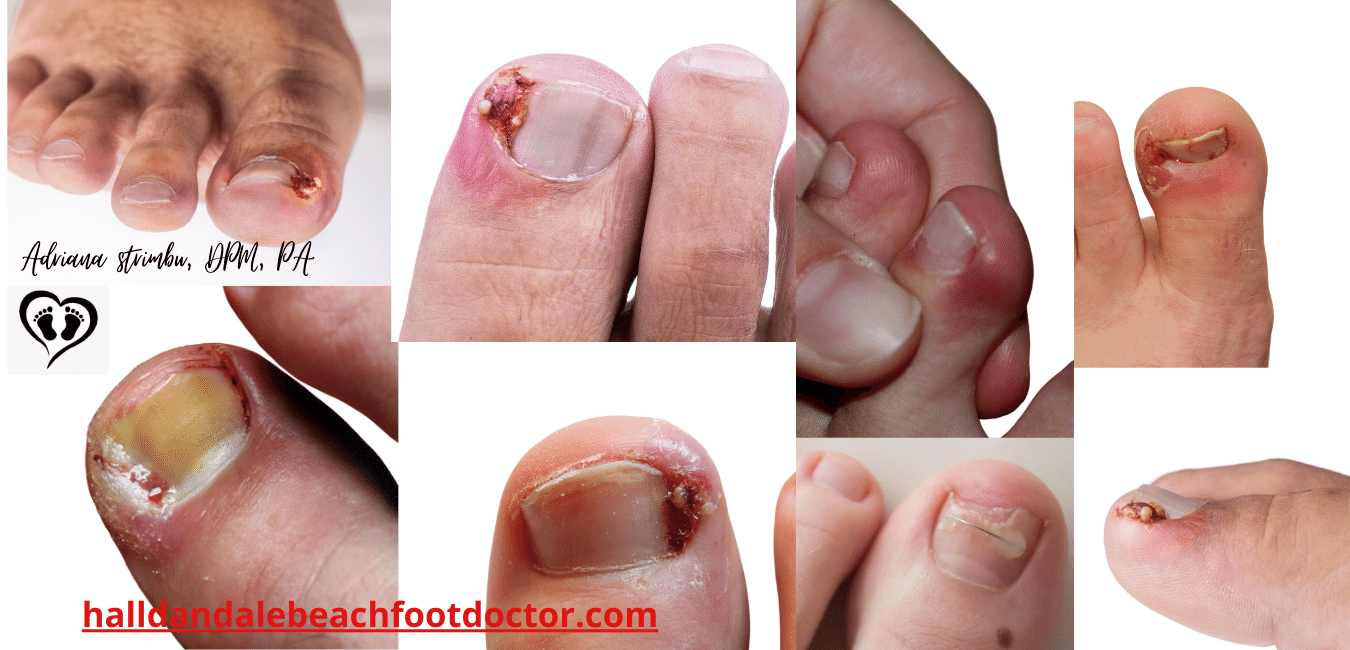
To Watch The Ingrown Toenail Videos Click Below:
Ingrown Toenail Removal Treatment - The Procedure
Depending on how advanced your ingrown toenail is, there are a few different procedures available for ingrown toenails.
Slant back is a simple cut into the toenail if your ingrown toenail is not so bad. Our Hallandale Beach podiatrist, Dr. Adriana Strimbu, will simply cut a small piece of your toenail on the affected side of the toe in order to alleviate the pain.
- Partial Nail Avulsion is a minor ingrown toenail removal surgery. It is easily done in our podiatry office. This procedure takes only about 5 minutes to do. Oral antibiotics are only needed if the toe is infected. First, out podiatrist, Dr. Adriana Strimbu will numb up the toe using local anesthesia. The patient will feel a little sting or burning in the toe when injecting the local anesthetic. This burning fades after about 10-20 seconds and the toe will be numb. You will not be able to feel anything else from this point on. Then our Hallandale Beach podiatrist will do the actual ingrown toenail removal surgery, where the affected part of the toenail will be removed. The word "partial" in the partial nail avulsion means only a small part of the toenail is removed. After the ingrown toenail is removed, the toe is dressed with antibiotic ointment and dressing.
- Partial matrixcetomy is done to avoid the toenail from being ingrown. This procedure takes under 10 minutes to do. In this procedure, a small part of the toenail is removed just as for the partial nail avulsion, but also a chemical is added in an attempt to try to burn the nail root. This will in most cases, prevent the toenail from getting ingrown again. This procedure cannot be done if your toe is infected because the chemical will not work. Also, this cannot be done in some diabetics or people with poor circulation, since you are taking the risk of infection or limb loss.
- Onyfix ingrown toenail treatment / repair is a painless, nonsurgical procedure for ingrown toenails. This procedure takes 3-5 minutes to do. Our Hallandale Beach podiatrist, Dr. Adriana Strimbu is among the first podiatrists to do this procedure in the US. This procedure was done in Europe for about 5 years and then last year it was brought into Canada and the beginning of this year (2020) was introduced in the USA. This cannot be done on an infected toenail. It's a easy way to fix your ingrown toenail and prevent it from growing into the skin on the sides of the toe. It involves applying a resin compound at the base of the toenail. When the toenail grows, it will grow with the Onyfix on it, which keeps it from growing into the skin. Basically it keep the toenail on the correct track. It's noninvasive and safe. Diabetics and people with poor circulation can have the Onyfix treatment done.
Why you should not do ingrown toenail removal at home
It is not recommended that you do ingrown toenail removal / treatment at home. Removing an ingrown toenail at home is what is referred to as "bathroom surgery".
Here are 3 reasons why you should not do ingrown toenail removal at home:
- You will be in intense pain and your toe needs to be numbed up before this is done.
- When you attempt to do this and you don't have the right instruments or if your instruments are not sanitary, your toe can get infected.
- It is hard to do it on yourself because you do not have the right angle or maybe yo are not able to see it well. You can easily cut yourself, which could lead to an infection. So you can make your ingrown toenail worse. Also if you are a diabetic or if you have poor circulation, doing this at home could be a disaster. It can even lead to a toe amputation.
Common Questions About Ingrown Toenails
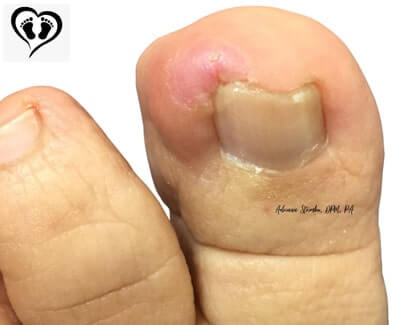
An ingrown toenail is when the corner or border of the toenail presses and grows into the surrounding skin. This will result in redness, pain, swelling and/or pus. Usually the big toe is most affected. Ingrown toenail is called onychocryptosis in medical terminology.
What causes an ingrown toenail?
- Wearing too tight shoes or hosiery or wearing ill fitting shoes
- Injuring your toe by stubbing, jamming or bumping of the toe
- Any pressure from physical activity that repeatably causes stress to the toes such as running, dancing or any other sports
How common are ingrown toenails?
In the US, there are more than 3 million cases of ingrown toenails each year.
What does a ingrown toenail look and feel like?
It all depends at what stage your ingrown toenail is. At first, your toe may look normal but you will feel like an ache or throbbing to the toe. Looking at the toe, you may not see anything wrong with the toe. Later on, the toe will slowly become more painful, red and swollen, which will worsen day by day. Pus can be present as well.
Can I leave an ingrown toenail alone?
Yes you can if you don't get too much pain or if it does not get infected. It is recommended that as soon as you sense some pain to the toe or you see that your toe starts getting red and swollen, you should start soaking your foot in warm water with epsom salt. This will help reduced the inflammation and pain. However, keep in mind that once your toenail starts growing into the skin, it is hard to get rid of it by doing nothing. Generally, you need to have to get out the small spicule from the ingrown to alleviate the pain, redness, swelling and/or infection. The reason your ingrown toenail does not heal by itself usually is because, this small spicule will act like a thorn in your toe. So your body will try to heal the toe, but because it acts just like a foreign body, many times your toe cannot heal until this foreign body is removed.
If you see that after you soak it, and the pain, redness, swelling and /or pus does not go away then you should seek help for a podiatrist. You can call our podiatry office at (954) 455-9404 to schedule an appointment or book an appointment online now.
When should I go to the doctor for an ingrown toenail?
Please consult with a podiatrist if your toe is red, swollen, painful or pus comes out from your toe. If your toenail is ingrown, surgery might be necessary to remove the ingrown toenail. Also your podiatrist might place you on oral antibiotics if there is infection of the toe.
Do I need a podiatrist for an ingrown toenail or who should i see for an ingrown toenail?
Podiatrists are highly trained to take care of your ingrown toenails. You should see a podiatrist right away if there is pain, redness, swelling, pus or other signs of infections. Diabetics and people with poor circulations are most at risk and should seek treatment immediately if they think that they have an ingrown toenail.
What is the difference between an ingrown toenail and a pincer toenail?
An ingrown toenail is often confused with a pincer toenail. An ingrown toenail has a normal shape toenail, meaning it is not raised. A pincer toenail is a very deformed toenail. It has an abnormal shape of decreasing width and increasing height of the nail plate.
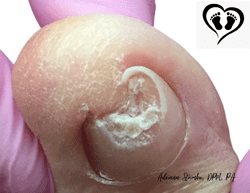
Can a nail salon fix an ingrown toenail?
A nail salon technician does not treat ingrown toenails. You should consult with a foot and ankle specialist (podiatrist) when it comes to treatment of an ingrown toenail.
Should I cut my ingrown toenail?
No. It is not recommended that you cut your ingrown toenail by yourself because you can get an infection. If your are a diabetic or if you have poor circulation this could end up in toe amputation.
What do I soak an ingrown toenail in?
Soaking your feet in warm water with epsom salt for 15 minutes two times per day will help decrease pain and inflammation until you get further treatment.
Do I get anesthesia when I have ingrown toenail removal?
Yes. Your toe will be numbed up before the podiatrist removes your ingrown toenail. The injection consists of a local anesthetic such as lidocaine, which will be injected into your toe about 5 minutes before the ingrown toenail removal.
How painful is ingrown toenail removal?
An ingrown toenail may be very painful. The actual removal of the ingrown toenail itself is not painful because your toe will be already numbed up by a local anesthetic injection. But some people say that the injection of the local anesthetic into the toe can be more painful than the actual surgery of the ingrown toenail removal itself. You may choose to have nonsurgical treatment of the ingrown toenails using the Onyfix Nail Repair System, which is a painless procedure.
Can I walk after ingrown toenail removal / avulsion?
Yes. Your toe will be numb due to the local anesthetic but it will wear out in about 2 -3 hours. It is recommended that after the ingrown toenail removal surgery, you rest for the rest of the day. Also avoid any physical activity for the next few days to allow the toe to heal well.
How painful is your toe after ingrown toenail removal surgery?
Your toe will not be painful for about 2-3 hours after the surgery. After that the anesthesia will slowly wear out and there will be minimal discomfort to the toe. It is recommended that you take over the counter Aleve or Ibuprofen if any pain.
How to tell if your toe gets infected after ingrown toenail removal surgery?
After the ingrown toenail surgery, it is possible that your toe can get infected. You will be noticing that the toe gets more red, swollen and the pain will continue and even get worse. You can also get more drainage or pus coming out of the toe.
Care after Ingrown Toenail Removal / Avulsion (Surgery)
Caring for your toe after the ingrown toenail removal is very important for the toe to heal without any infection.
Here are some recommendations for care after ingrown toenail removal:
On the first day, keep the bandage clean and dry. You don't have to open the dressing on the first day unless you feel is too tight, then you can open it up but reapply a new dressing.
Avoid any pressure to the toe during the healing period. Sandals or open toe shoes or other comfortable shoes that do not press on the toe are recommended.
The following day after the ingrown toenail removal surgery, remove the bandage from your toe and soak the foot in warm water with epsom salt. If you do not have espom salt, you can soak in warm water with one cup of white vinegar and 2 tablespoons of white salt.
Soaking is best to be done for 15 minutes twice a day.
Do this soaking twice a day till you go back to the doctor in about 7-10 days or until the toe is completely healed.
After each soaking, dry the toe very well and apply antibiotic ointment to the toe and a non-adhesive bandaid.
Avoid any tight dressing to the toe. You do not want to cut off the blood flow to the toe.
Avoid too much antibiotic ointment to the toe. Too much topical antibiotic after the ingrown toenail removal can cause maceration and it can keep the toe too wet. This can slow down the healing of the toe.
Keep the toe open for about 20-30 minutes each day when your are at home to let it air out and help with the healing.
Avoid any swimming, baths or pools. You don't want any bacteria to get into your toe and your toe can get infected.
You may take some over the counter pain reliever such as Aleve or Ibuprofen if you feel that you get some pain after the anesthesia wears out.
Cost and Insurance Information for Ingrown Toenails Removal and Treatment
How much does it cost to see a podiatrist for an ingrown toenail?
The price will vary. However, it will cost you the visit with the podiatrist and the procedure for the removal of the ingrown (surgical or nonsurgical) depending on what is done. But the price can vary between $200 - $400.
Is treatment for ingrown toenails covered by insurance?
Yes. Treatment of ingrown toenails is covered by insurance except for the Onyfix Toenail Repair System. Onyfix treatment is not covered by the insurance.
